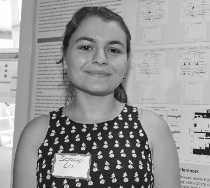Sophie Lis
 Turrigiano Laboratory
Turrigiano Laboratory
Department of Biology
Brandeis University
Applying Quality Control to Spike Sorting And Clustering Algorithm to Improve Data Analysis
Poster Abstract
In order to understand neuronal behavior in the living brain, scientific investigations rely on chronically implanted electrode arrays to track activity of single neurons over time. Resultant signals are analyzed via spike sorting and clustering algorithms, where waveforms are grouped into collections of spikes that putatively originate from the same neuron. However, successful single-unit identification during long-term implantation is error-prone due to electrode drift in neural tissue or background noise interference. This can result in the false splitting of spikes from one neuron into multiple clusters, or the merging of spikes from two neurons into one cluster, losing track of single-unit identity.
To evaluate the outcome of the present algorithm used in the Turrigiano lab, MATLAB was used to carry out quality control on given clusters as based on recordings from visual cortex (V1) in rats. A graphical user interface (GUI) was created to track hourly changes in each cluster to examine characteristics indicative of potential cluster errors. This allowed us to determine and isolate the presence of time points throughout the duration of the experiment where incorrect clustering occurred and to prevent the inclusion of this data in further analysis. This will allow for cleaner data analysis and will further future analysis of neuronal activity in visual cortex, as demonstrated with an example cluster. These outcomes will act as a grounding step for future re-evaluation and optimization of the present spike sorting and clustering algorithm in order to produce more reliable data analysis.
Personal Statement
My involvement in the lab this summer was a phenomenal opportunity to experience day-to-day life working in science and to carry out important research that positively affected data analysis in the Turrigiano lab. It was extremely important for me to be
able allocate this time so as to make progress on my project and to make headway into aspects of research I had little time to explore during the school year. Thanks to very generous support of the M.R. Bauer Foundation, I was able to dedicate the entirety of these past ten weeks to building from head to toe graphical user interfaces (GUIs) to evaluate quality control of neural recordings. Most importantly, these tools were able to be implemented to identify location and types of errors during analysis, a major step in working to improve the way that neural recordings are analyzed to identify single cells followed over time.
These past few months have thus allowed me to reflect on my motivation to pursue scientific research and my future goals, as I enter my senior year at Brandeis and begin to think about next steps in my professional career. This experience has cemented my desire to seek positions in scientific programming or computational neuroscience following graduation, and to continue bettering my MATLAB skills and my ability to write clean, efficient code. I am extremely indebted to the M.R. Bauer Foundation for
this chance to live out 9-5 life as a research assistant, especially given the financial difficulties I have experienced throughout my time at Brandeis. I would like to sincerely thank the donors who made this opportunity possible for me and allowed me to do full-time research this summer without any barriers, and to really experience life as a scientist.